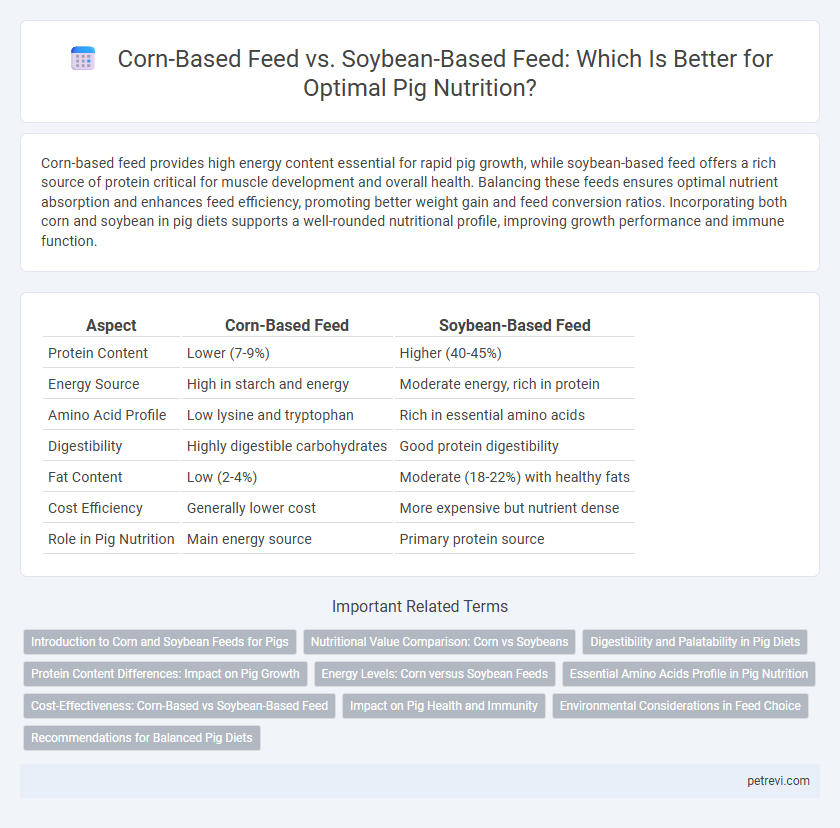Corn-based feed provides high energy content essential for rapid pig growth, while soybean-based feed offers a rich source of protein critical for muscle development and overall health. Balancing these feeds ensures optimal nutrient absorption and enhances feed efficiency, promoting better weight gain and feed conversion ratios. Incorporating both corn and soybean in pig diets supports a well-rounded nutritional profile, improving growth performance and immune function.
Table of Comparison
| Aspect | Corn-Based Feed | Soybean-Based Feed |
|---|---|---|
| Protein Content | Lower (7-9%) | Higher (40-45%) |
| Energy Source | High in starch and energy | Moderate energy, rich in protein |
| Amino Acid Profile | Low lysine and tryptophan | Rich in essential amino acids |
| Digestibility | Highly digestible carbohydrates | Good protein digestibility |
| Fat Content | Low (2-4%) | Moderate (18-22%) with healthy fats |
| Cost Efficiency | Generally lower cost | More expensive but nutrient dense |
| Role in Pig Nutrition | Main energy source | Primary protein source |
Introduction to Corn and Soybean Feeds for Pigs
Corn-based feed provides high energy content essential for pig growth and weight gain, primarily due to its rich starch composition. Soybean-based feed offers a superior source of protein and essential amino acids like lysine, which are critical for muscle development in pigs. Combining both feeds optimizes nutrient balance, enhancing overall pig health and production efficiency.
Nutritional Value Comparison: Corn vs Soybeans
Corn-based feed provides high energy content primarily from carbohydrates, making it an excellent source for meeting the calorie requirements of pigs. Soybean-based feed offers a superior protein profile with essential amino acids like lysine, critical for muscle development and growth in pigs. Combining corn and soybean feeds ensures a balanced diet, optimizing both energy and protein intake for improved pig nutrition and performance.
Digestibility and Palatability in Pig Diets
Corn-based feed offers higher energy digestibility due to its starch content, promoting efficient nutrient absorption in pigs. Soybean-based feed provides superior protein quality and amino acid profile, enhancing growth performance and muscle development. Palatability tends to be higher in corn-based diets, encouraging feed intake and supporting optimal pig nutrition.
Protein Content Differences: Impact on Pig Growth
Corn-based feed typically contains lower protein levels, around 8-10%, whereas soybean-based feed offers a higher protein content, averaging 44-48%, which is crucial for pig growth and muscle development. Higher protein in soybean feed enhances amino acid profile availability, directly supporting faster weight gain and improved feed efficiency. Optimal pig nutrition often requires balancing corn's energy density with soybean's protein quality to maximize growth performance.
Energy Levels: Corn versus Soybean Feeds
Corn-based feed provides higher energy density compared to soybean-based feed, making it a preferred choice for rapid weight gain in pigs. Soybean feed, while lower in energy, offers higher protein content essential for muscle growth and overall health. Balancing corn and soybean feed optimizes energy intake and nutrient supply for efficient pig nutrition.
Essential Amino Acids Profile in Pig Nutrition
Corn-based feed for pig nutrition offers high energy content but presents limitations in essential amino acids, particularly lysine and tryptophan, crucial for optimal growth and protein synthesis. Soybean-based feed delivers a more balanced essential amino acid profile, including higher levels of lysine, methionine, and threonine, supporting improved muscle development and overall pig health. Formulating pig diets by combining corn and soybean meal enhances amino acid availability, promoting efficient feed conversion and maximizing growth performance.
Cost-Effectiveness: Corn-Based vs Soybean-Based Feed
Corn-based feed generally offers a more cost-effective solution for pig nutrition due to its lower market price per ton and higher energy density, which supports efficient weight gain. Soybean-based feed provides essential amino acids like lysine but tends to be more expensive, often increasing overall feed costs without proportionate growth benefits. Optimizing pig diets typically involves balancing corn's energy benefits with soybean's protein quality to maximize cost-efficiency and growth performance.
Impact on Pig Health and Immunity
Corn-based feed provides high energy levels beneficial for pig growth but lacks sufficient amino acids critical for optimal immune function. Soybean-based feed offers a balanced profile rich in essential amino acids and bioactive compounds that support enhanced immune responses and better overall pig health. Incorporating soybean meal alongside corn can improve nutrient balance, strengthening pigs' resistance to diseases and promoting robust immune system development.
Environmental Considerations in Feed Choice
Corn-based feed for pigs generally has a lower water footprint and requires less land compared to soybean-based feed, making it a more environmentally sustainable option in terms of resource use. Soybean cultivation is associated with higher greenhouse gas emissions and deforestation risks, particularly in tropical regions, which can significantly impact biodiversity and carbon sequestration. Selecting corn-based feed can reduce the environmental impact of pig farming by minimizing habitat loss and lowering overall carbon emissions in feed production.
Recommendations for Balanced Pig Diets
Corn-based feed provides high-energy carbohydrates essential for pig growth, while soybean-based feed offers rich protein content critical for muscle development and immune function. A balanced pig diet should incorporate approximately 60-70% corn to meet energy requirements and 20-30% soybean meal to supply adequate amino acids, particularly lysine, for optimal performance. Including vitamin and mineral supplements further ensures pigs receive a complete nutrient profile, promoting health and efficient feed conversion rates.
Corn-based feed vs Soybean-based feed for Pig nutrition Infographic

 petrevi.com
petrevi.com